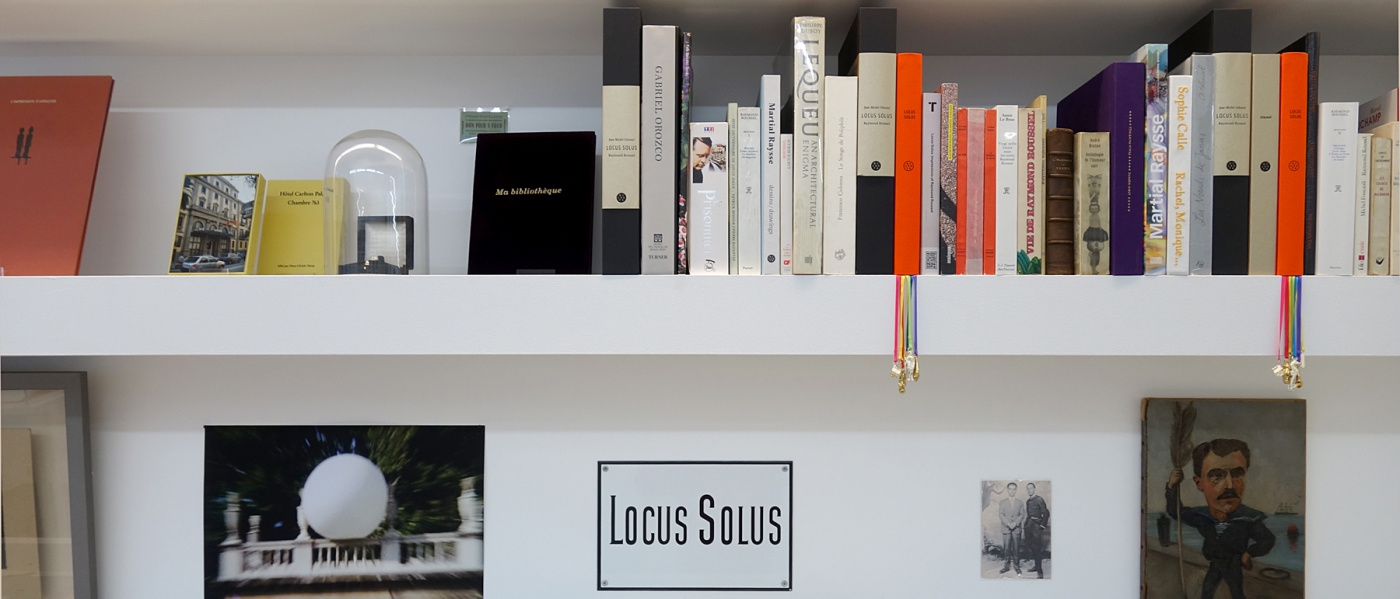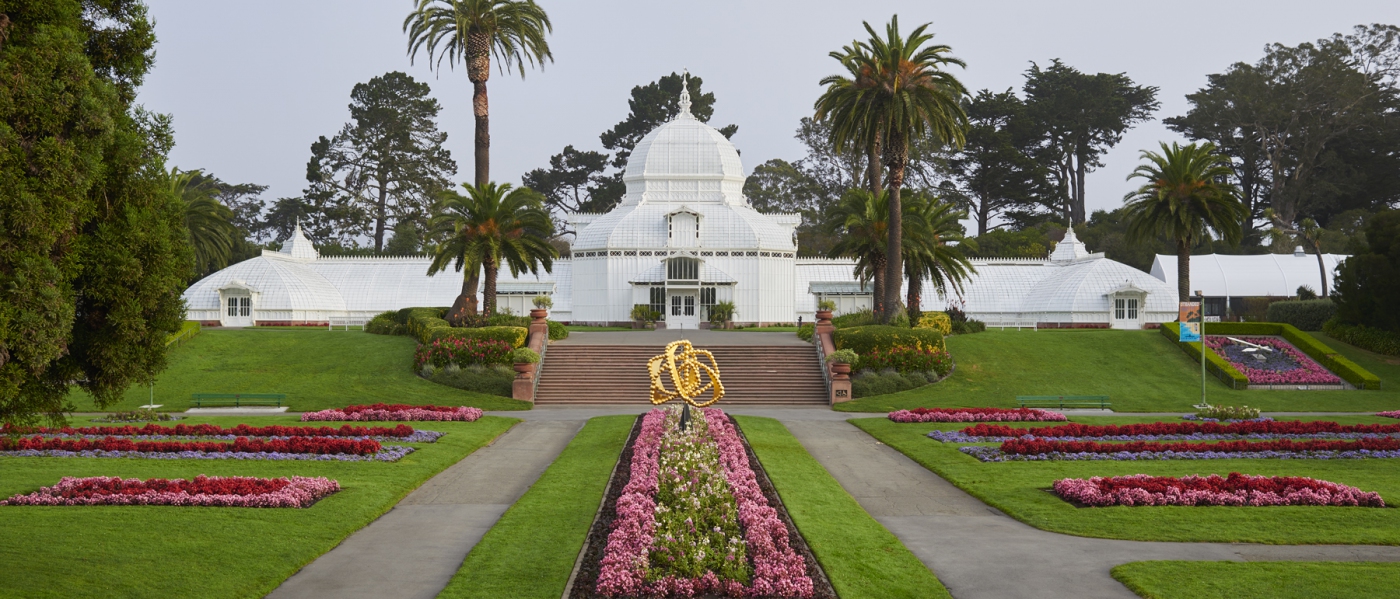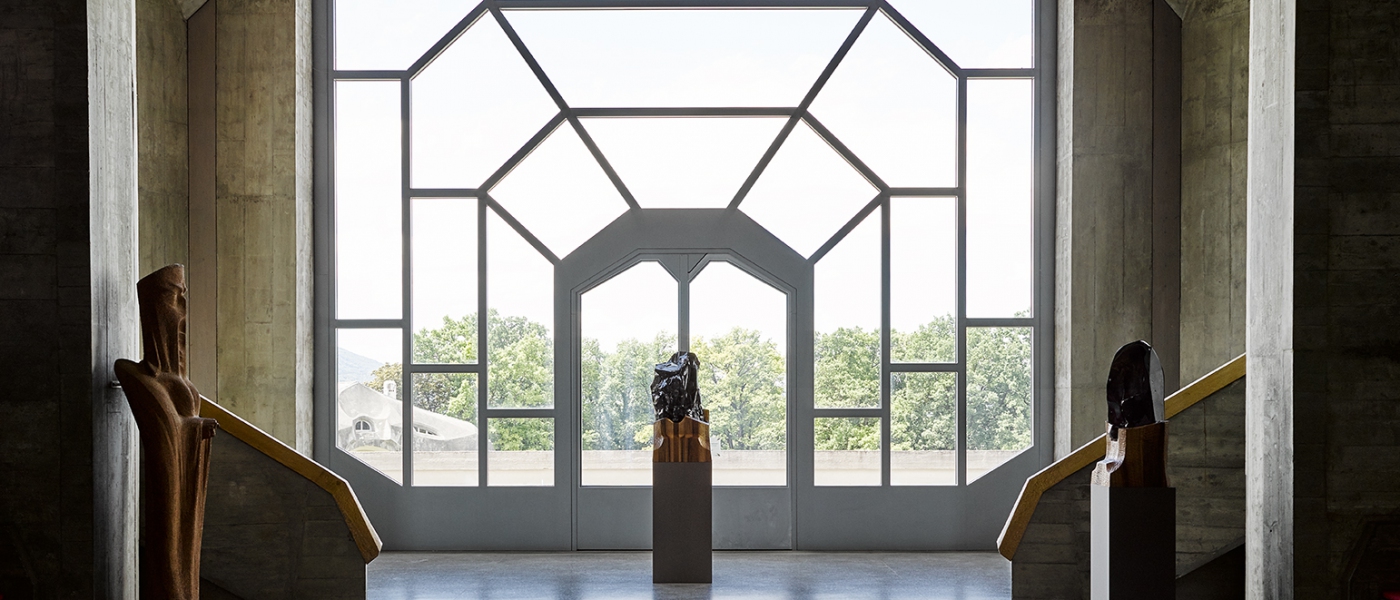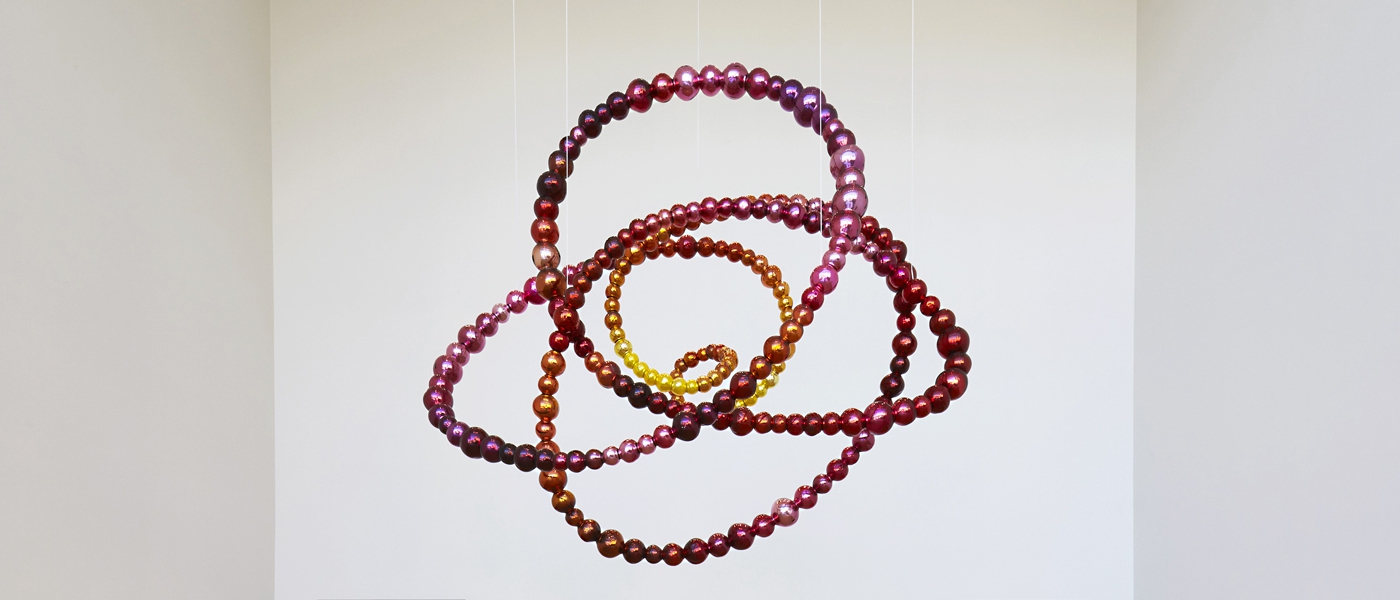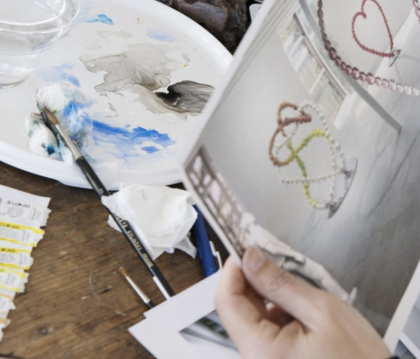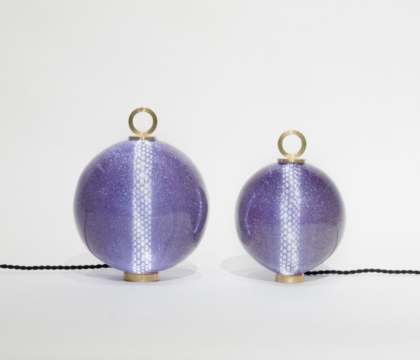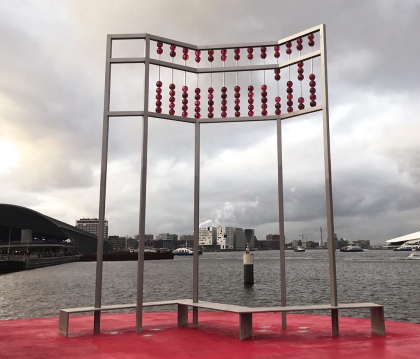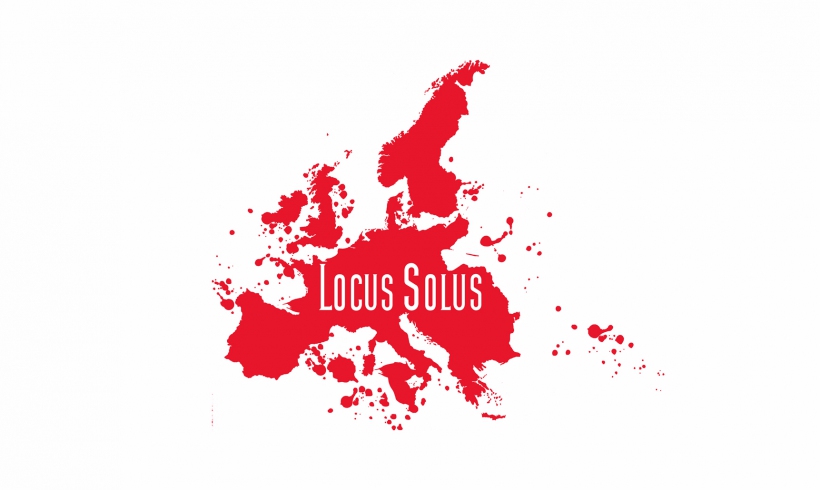
Locus Solus
October - December 2015, Galerie Dilecta
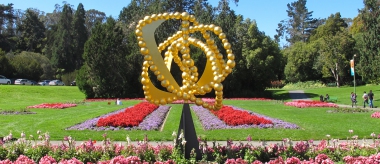
#OthonielVersailles @836M & #OthonielSanFrancisco @ConservatoryOfFlowers
September 2015 - February 2016, 836M Gallery & Conservatory of Flowers, San Francisco
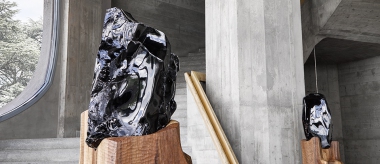
Invisibility Faces
June - July 2015, Goetheanum, Dornach, Switzerland
Locus Solus
October - December 2015, Galerie Dilecta
Discover the exhibitionLocus Solus by Raymond Roussel
Published in 1914, not long before the Old World descended into a bloody war, Locus Solus is Raymond Roussel’s enigmatic masterpiece (Paris, 1877, Palermo 1933). The narrative, a guided tour of scientist Martial Canterel’s country estate, reveals a series of his inventions, scattered throughout his property: complex automatons or "bachelor machines” with their strange, brilliant poetry, inspired by evocative stories rife with symbols, lexical games and recurring images.
Othoniel’s Locus Solus
Seven ribbons in the colors of the rainbow, echoing Canterel’s seven inventions, are sewn into the book to mark each of its seven chapters. Othoniel has also inserted his own graphic interventions into the book, as well as images evoking Roussel’s world by other artists (James Lee Byars, Gabriel Orozco or Martial Raysse). In this way, Othoniel allows readers to discover the novel’s secret, revealing it delicately, as if uncovering a diamond buried in the sand. Not unlike Canterel, who welcomed guests at the gate of his property to present the seven wonders it contains, the artist becomes our guide, leading us through the corridors of a Roussellien world. In addition, Othoniel has designed a book-object full of surprises, including a tarot card, photographs and precious medallions.
Othoniel and Roussel
Othoniel has long been haunted by Roussel’s work; one of his first artistic gestures, nearly twenty-five years ago, was to embark on a journey in search of the literal "Locus Solus" villa. Roussel’s books, and Locus Solus in particular, have profoundly influenced Othoniel’s artistic practice, sparking his desire to explore the wonderful, the strange and the enigmatic. "He preserves the mystery, the word play, a sense of the grotesque, the creation of a poetic universe. A document seen by chance in the journal of the Bibliothèque nationale led him to clues about Locus Solus, the mythical villa described by Roussel [...], and to imagine that he might actually find it. He pursued the mystery in a search that, based on a photograph that Roussel had preciously archived, would ultimately lead him [...] to the house of a writer friend, baptized Locus Solus in homage to the famous book. From this adventure, he retained a series of photographs taken in the garden, as well as a Oulipo-style text by François Caradec." (Catherine Grenier).
The exhibition at Galerie Dilecta
Othoniel’s limited-edition artist’s book, from the original text by Raymond Roussel, as well as his first-run edition L’Etoile d’or, were presented in an exhibition conceived by the artist from October 16 to December 19, 2015, at the Dilecta gallery in Paris.
#OthonielVersailles @836M & #OthonielSanFrancisco @ConservatoryOfFlowers
September 2015 - February 2016, 836M Gallery & Conservatory of Flowers, San Francisco
Discover the exhibition#OthonielVersailles @836M & #OthonielSanFrancisco @ConservatoryOfFlowers
Jean-Michel Othoniel’s travelling exhibition makes its second stop in the USA from September 26, 2015 to January 14, 2016.
Following the Isabella Stewart Gardner Museum in Boston, Massachusetts, San Francisco welcomes the artist to two venues in the city centre:
La Rose des Vents, a kinetic sculpture made of gold and aluminum, is installed outside the Conservatory of Flowers in Golden Gate Park, in partnership with the San Francisco Arts Commission and the San Francisco Recreation and Parks Department.
This sculpture, which pays homage to the compass rose, an ancient device used to gauge wind direction, is installed in front of the Conservatory of Flowers in Golden Gate Park, where it can shimmer in the sun and move with the wind. "We welcome Jean-Michel to Rec and Park's Conservatory of Flowers," said Phil Ginsburg, SF Rec and Parks General Manager. "We are thrilled to be in partnership with the San Francisco Gallery 836M to present such a new, exciting art element to our public parks." During the exhibition, the owners of the gallery, Sébastian and Julie Lépinard, will work with its partners to find La Rose des Vents a permanent public art home in San Francisco.
The glass sculpture Peony, the Knot of Shame is on display at the 836M gallery, a new non-profit space located on Montgomery Street. The 836M exhibit will also feature sketches, watercolors and bronze models created for Othoniel's Versailles project: Les Belles Danses (The Beatiful Dances),three fountain sculptures in the chateau's gardens, which evoke Louis XIV dancing, entitled inaugurated in May 2015. A series of new gold paintings is also on display.
Othoniel’s Peony, the Knot of Shame began with an original watercolor for the "Picture and a Poem" series in The New York Times. The watercolour and sculpture were inspired by and paired with a piece by American poet Brenda Shaughnessy. Othoniel’s sculpture expresses what he calls “the erotic exuberance” of Shaughnessy’s poem, which begins, "Was I ever truly happy, like some girl in a red tank top eating sunlight in Spring?"
The gallery's webste is: www.836m.org
Invisibility Faces
June - July 2015, Goetheanum, Dornach, Switzerland
Discover the exhibition CaptionsInvisibility Faces
From June 14 to July 5, Jean-Michel Othoniel presents "Invisibility Faces" at the Goetheanum in Dornach, Switzerland. The five carved obsidian blocks shown in this exceptional space are meant as symbols crystallizing the idea of absence, like three-dimensional shadows.
In early May, after four years of work, a new permanent installation by Othoniel consisting of three monumental fountains entitled Les Belles Danses (The Beautiful Dances), was inaugurated at the Château de Versailles.
One can hardly imagine a more surprising leap than from pre-Enlightenment Versailles to the radical ideas about the human condition expressed in the Goetheanum, built in 1924-1928 by the scientist, philosopher and Goethe scholar Rudolf Steiner.
Othoniel was initially attracted to the Goetheanum after discovering a small lamp from the 1930s by Goetheanum sculptor Oswald Dubach in a Parisian antique shop. The shape of the carved wooden lamp, unspectacular yet highly expressive, led him to Baukunst, the workshop on the Goetheaum site, the same place where Dubach had once worked and possibly manufactured the lamp. In collaboration with the Baukunst studio and Glassworks (Münchenstein), Othoniel produced a new body of work entitled Invisibility Faces.
Another, more hidden link can also explain Othoniel’s interest in Goetheanum: his fascination with materials and their inherent transformative possibilities.
Twenty-six years ago, at the beginning of his career, Othoniel traveled to the Aeolian Islands north of Sicily to look for natural sulfur. There, he first learned about obsidian, a naturally occuring volcanic glass. But obsidian behaves in suprising ways. Although coloured glass has a certain transparency, obsidian appears to be totally opaque; it has a kind of inner transparency, as if light were coming from within.
How is this possible? It is perhaps this paradoxical sensation of darkness and light that provides obsidian with its mysterious presence, and leads us to understand why Othoniel chose the unusual title for this series: It is not about invisible faces, but about the face of invisibilty.
Johannes Nilo
--
Image 2/6
Jean-Michel Othoniel facing Invisibility Face 1, 2015
Obsidian, chestnut carved wood base
40 1/8 x 20 1/8 x 21 1/4 in.
Collection of the artist
Image 3/6
Invisibility Face 1 (left), 2015
Obsidian, chestnut carved wood base
40 1/8 x 20 1/8 x 21 1/4 in.
Collection of the artist
&
Invisibility Face 5 (right), 2015
Obsidian, chestnut carved wood base
30 1/8 x 15 1/8 x 17 3/8 in.
Collection of the artist
Image 4 & 5 /6
Invisibility Face 4, 2015
Obsidian, chestnut carved wood base
33 1/2 x 16 x 17 1/8 in.
Collection of the artist
Image 6/6
Invisibility Face 3, 2015
Obsidian, chestnut carved wood base
29 1/8 x 15 3/8 x 16 3/8 in.
Collection of the artist
Jean-Michel Othoniel : Secret Flower Sculptures
March - September 2015, Isabella Stewart Gardner Museum, Boston, Massachusetts
Discover the exhibition CaptionsJean-Michel Othoniel : Secret Flower Sculptures
Jean-Michel Othoniel's recent exhibition "Secret Flower Sculptures" opened at the Isabella Stewart Gardner Museum on March 12, 2015. A site-specific sculpture and four new paintings produced for the museum’s Hostetter Gallery are on display, along with a presentation of his 2015 Versailles project. Another sculpture is installed in the museum’s garden.
Two large sculptures face one another in the museum gardens. Peony, The Knot of Shame, Othoniel's largest hanging knot to date, is suspended from the ceiling of the Hostetter Gallery and surrounded by his gold-leaf paintings. Outdoors at the museum entrance La Rose des Vents, a gold aluminum kinetic sculpture, captures and reflects the sunlight as it turns in the wind.
The inspiration for Othoniel's "Secret Flower Sculptures" came during his year-long residency at the museum, in a program that prolongs Isabella Stewart Gardner’s legacy by supporting artists.
During his month-long residency, Othoniel discovered an 18th-century book at the Boston Public Library, The Art of Describing Dance by Raoul-Auger Feuillet, in which the master choreographer describes his work on ballets and royal dances during Louis XIV’s reign in France.
Inspired by the book and by his experience at the Gardner musem, Jean-Michel Othoniel conceived 3 fountain sculptures, entitled Les Belles Danses (The Beautiful Dances), for Versailles' Water Theatre grove. His installation opens on May 12th, 2015, at Versailles. For the commission, Othoniel won an international competition in collaboration with the French landscape designer Louis Benech. This will be the first time in 300 years that a contemporary sculpture has been permanently installed in Versailles’s gardens.
This American exhibition at the Gardner Museum marks the first time this historic project is being revealed. Inspired by Louis XIV's dance steps, several of the drawings made in Boston will be shown alongside Les Belles Danses, as will two bronze models for the sculptures. The Boston Public Library will also loan its original copy of Raoul-Auger Feuillet’s book to the Isabella Stewart Gardner Museum for the exhibit.
In addition, Othoniel assembled his own personal tour through the Gardner Museum, inspired by his passion for flowers and their hidden meanings, which informed his view of its collection as a beautiful garden. Drawings and pictures produced during his artist-in-residency also inspired the publication of his new book, The Secret Language of Flowers, a herbarium in which Othoniel explores the symbolsm of flowers, as seen through works in Isabella Stewart Gardner’s collection.
--
Image 1/8
Peony, the Knot of Shame, 2015
Mirrored Glass, Stainless Steel
118 1/8 x 118 1/8 x 78 3/4 in.
Courtesy Galerie Perrotin
The Knot of Shame (in the center, below the sculpture), 2014
Ink on white gold leaf, lithographic monotype on canvas
140 x 105 x 5.5 cm (55 1/8 x 41 3/8 x 2 1/8 in.)
ed 1/3
Collection of the artist
The Knot of Shame (on the left), 2014
Ink on white gold leaf, lithographic monotype on canvas
55 1/8 x 41 3/8 x 2 1/8 in.
Ed 1/3
Collection of the artist
The Knot of Shame (on the right), 2014
Ink on white gold leaf, lithographie monotype on canvas
55 1/8 x 41 3/8 x 2 1/8 in.
Ed 1/3
Collection of the artist
Image 2/8
Peony, the Knot of Shame, 2015
Mirrored Glass, Stainless Steel
118 1/8 x 118 1/8 x 78 3/4 in.
Courtesy Galerie Perrotin
Image 3/8
Peony, the Knot of Shame (detail), 2015
Mirrored Glass, Stainless Steel
118 1/8 x 118 1/8 x 78 3/4 in.
Courtesy Galerie Perrotin
Image 4/8
Aquarelle (Peony, The Knot of Shame), 2013
Watercolor on paper
14 1/8 x 10 1/4 in.
Private collection
Image 5/8
Peony, the Knot of Shame, 2015
Mirrored Glass, Stainless Steel
118 1/8 x 118 1/8 x 78 3/4 in.
Courtesy Galerie Perrotin
Image 6/8
Entrée Grave pour Homme, Boston, 2011
Watercolor on paper
13 3/8 x 17 3/8 x 1 3/8 in., framed
Collection of the artist
Image 7/8
Raoul-Auger Feuillet, The Art of describing dance, 1700
Boston Public Library
Image 8/8
The Bourrée of Achilles (on the left), 2014
aluminium, gold
12 1/4 x 78 3/8 x 78 3/8 in.
Courtesy Galerie Perrotin
The Rigaudoon of Peace (right), 2013
Gold aluminium model, blue Murano glass bead, stainless steel structure.
12 1/4 x 74 3/4 x 81 1/8 in.
Courtesy Galerie Perrotin
